How to preserve your fresh herbs
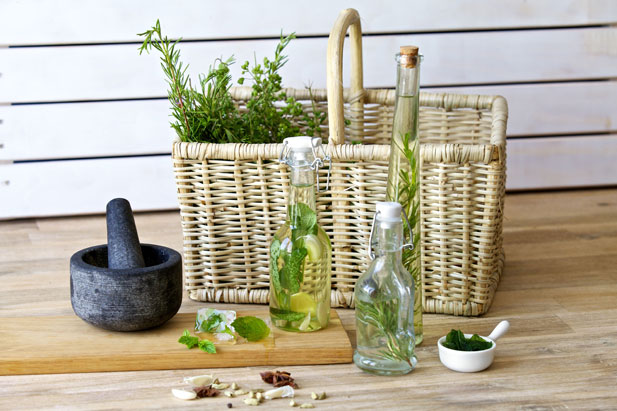
1. Herb butter
You’ve probably seen the little butter sausages in the supermarket aisles but did you know that this is one of the easiest ways to keep your fresh herbs? Just soften a block of butter (leave it on the counter until it is soft to touch), mix it with some roughly chopped herbs, grate in some garlic, then mix the whole lot together, ensuring the herbs and garlic are evenly distributed in the butter.
Spoon the mixture onto a sheet of cling film and, using the film, shape into a log, squeezing as much air out as you can. Twist the ends and fold them back over the log to seal. Half a block of butter makes the log pictured, so you can also separate the butter into two and make two logs with one block. Use whatever herbs you have and mix up your favourites. Do you often fry mushrooms in thyme and garlic? Make a thyme and garlic log and slice a piece off when you need it. And, don’t let savoury flavours rule, try a cinnamon and vanilla butter. Butters can be stored in the freezer for months and in the fridge for several weeks. They also make a tasty gift, so make extra for the clamouring hordes.
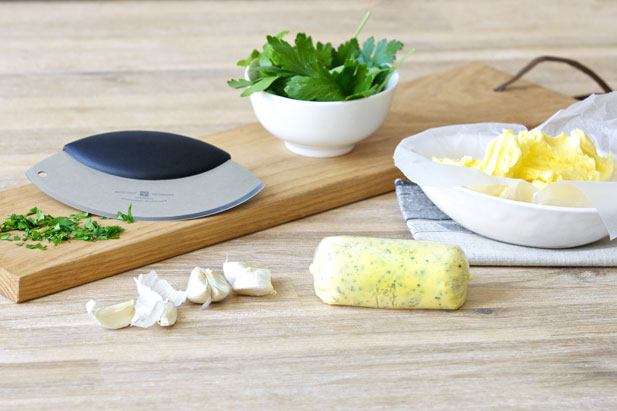
2. Rubs
There are endless spice mixes and rubs in shops but did you know that you can make your own? The best way is to dry fry some spices (cumin seeds, pimento seeds, cardamom or coriander seeds) in a pan, then leave to cool. Pummel them in a pestle and mortar or in the food processor, and add to a little flaked salt and some dried herbs like rosemary to make an excellent rub for meat, or a herb mix to add to food while cooking. Frying releases the flavours of these dried spices. Store in an airtight container in a cool place and they should last a good few months (if they make it that long).
3. Oil or vinegar infusion
Infused oils and vinegars look gorgeous and are expensive to buy. The good news is that they are simple to make. All you need are some sprigs of fresh, hardy herbs or even a couple of chillies. To make an infused oil, have a clean bottle handy (these are fantastic and have an airtight seal), heat some good quality oil (you can use olive oil) on the stove until just warm, then allow to cool. Pop some sprigs of fresh herbs into the bottles. Hardy herbs like rosemary and thyme work well, as do whole, clean chillies but feel free to experiment. You can even pop a few halved raw garlic cloves in but bear in mind that their flavour will infuse the oil and get stronger with time, so be circumspect. Also, if you do decide to use garlic, leave the oil to infuse in the fridge. Leaving it at room temperature will allow bacteria to grow. When the oil is cool, pour it into the bottles, either using a funnel or pour carefully from a jug, and stop with a clean, airtight stopper. Store in a cool, dark place for a few weeks to let the flavours develop.
To make an infused vinegar, leave herbs or even chillies to dry somewhere warm for a couple of days (or dry out in a warm oven for a few hours), to reduce moisture content. Pop into the bottles and pour a good quality vinegar over it. For maximum visual effect a white vinegar is best (white wine, apple cider or white balsamic), but a dark vinegar would also work. Stop with an airtight seal, and leave to infuse for a few weeks before using. Infusing garlic into vinegar? The acid in vinegar kills any bacteria, which means it is safe to leave at room temperature.
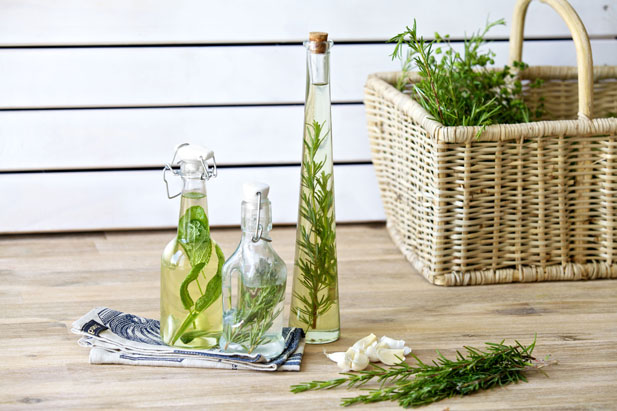
4. Dried
Did you know that you can also dry your own herbs? Yup, this is true. Tie bunches of herb sprigs together, hang in a cool, dark, well-ventilated place and leave until dry to the touch. Make sure the area is not damp and the sprigs are dry, as this will encourage mould. When the herbs crumble to the touch, crumble them into airtight jars and use as you would any other dried herbs. Bear in mind that most shop bought dried herbs are irradiated, which makes them last longer, so try to use these within a few months for best results. Also, the strength of the flavour will dissipate with time, so use them quick to get the most munch for your bunch.
5. Frozen
No space for more bottles? Soft, leafy herbs work well frozen. Simply chop roughly and fill ice cubes with about a tablespoon of chopped herbs, then top with water and freeze. Pop out of the ice tray and store in a ziplock bag in the freezer until needed, then pull out a couple of blocks to add to soups, sauces and other dishes. Frozen mint is fantastic for cocktails and in water. You can even freeze fresh blueberries or slices of lemon, if the mood takes you. You can also freeze in oil but remember to do these ones with herbs you would ordinarily fry, for example, with thyme.
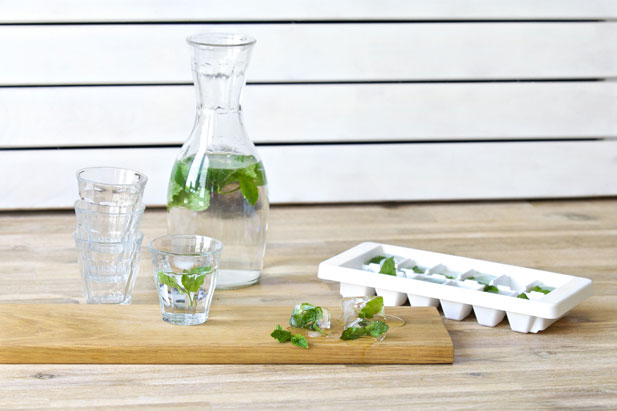
6. Pesto
Pesto is another gem and freezes beautifully. We’ve a little tutorial on how to make basil pesto but don’t let not having basil stop you. Pesto literally means ‘to pound’ so you can use any combination of herb, garlic, cheese, nuts (oily is best) and oil. Think, coriander pesto with macadamia nuts or parsley and pistachio pesto. Pesto can also be frozen in small quantities, just remember to store in a container than won’t crack when frozen leaving a bit of space in the top of the jar for expansion of the contents as it freezes.
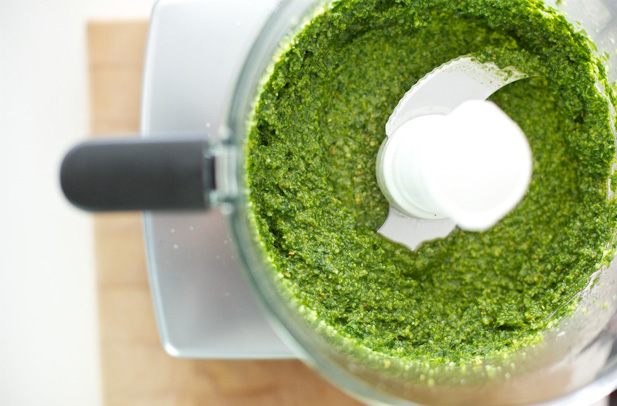
7. Deep fried
Some leafy herbs work extremely well when fried. It retains their bright colours and makes them crispy. Sage works particularly well. Heat oil in a pan – when a herb dipped into it gets bubbles around it, it is hot enough. Drop in individual leaves, a couple at a time, and remove with a slotted spoon when they float to the top. Allow to dry on a paper towel and store in an airtight container. Experiment – not all herbs will work, but if they do, they add a wonderful crispy element to salads and pasta dishes like this pumpkin and sage ravioli.
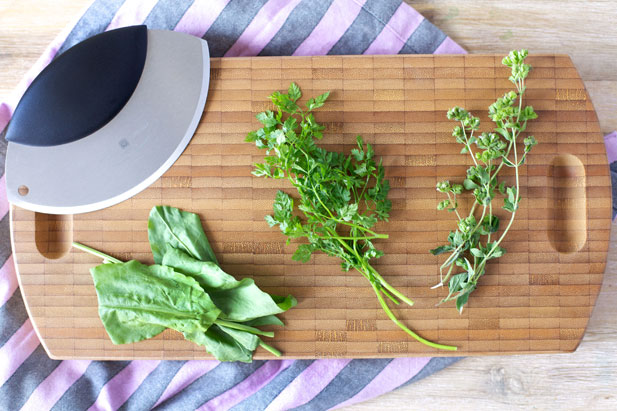
Got any other great ideas for making the most of your herb garden? Let us know.
